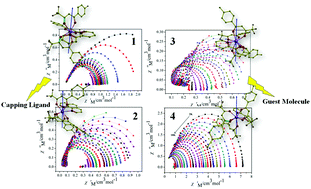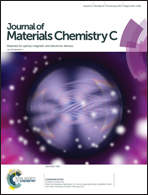Ligand field fine-tuning on the modulation of the magnetic properties and relaxation dynamics of dysprosium(iii) single-ion magnets (SIMs): synthesis, structure, magnetism and ab initio calculations†
Abstract
To fine-tune the magnetic anisotropy and further modulate the magnetic properties and relaxation dynamics of dysprosium(III) single-ion magnets (SIMs), it is crucial to explore their controllable synthesis and conduct a systematic theoretical investigation. Herein, the mononuclear Dy(III) precursor, [Dy(DMF)2(tffb)3] (tffb = 4,4,4-trifluoro-1-(4-fluorophenyl)-1,3-butanedione), as a “metalloligand” towards different capping ligands, affords two new mononuclear Dy(III) complexes in different solvent systems, [Dy(bpy)(tffb)3]·(C4H8O2)1/3 (1) and [Dy(Phen)(tffb)3] (2) (bpy = 2,2′-bipyridine, Phen = 1,10-phenanthroline). Using 4,4,4-trifluoro-1-(4-methylphenyl)-1,3-butanedione (tfmb) as a ligand with the coligand bpy, [Dy(bpy)(tfmb)3] (3) is obtained. In 1,4-dioxane solution, interestingly, complex 3 undergoes a dissolution/reorganization process to transform into 4, [Dy(bpy)(tfmb)3]·0.5C4H8O2. Structural analyses indicate that Dy(III) in 1–4 adopts an approximately square-antiprismatic (SAP) coordination environment with D4d axial symmetry. The magnetic properties of 1–4 are investigated and the M versus H data exhibit evident butterfly-shaped hysteresis loops at 2 K for 1–4. Although all the Dy(III) ions in 1–4 adopt similar configurations, their magnetization dynamics are apparently different from each other, as shown by the various heights of the effective energy barrier (Ueff) of magnetization reversal. To deeply understand their different magnetic behaviours, the magnetic anisotropy of 1–4 is systematically studied by ab initio calculations. The theoretical results further indicate that the capping ligands could play an important role in the fine tuning of the SMM property via an effect on the equatorial electrostatic potential, whereas the inclusion of guest solvent molecules could significantly influence the axial electrostatic potential, leading to a strong effect on the SMM property.



 Please wait while we load your content...
Please wait while we load your content...